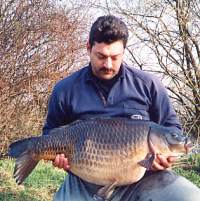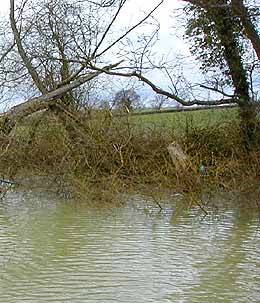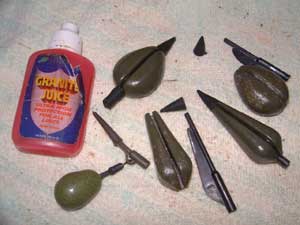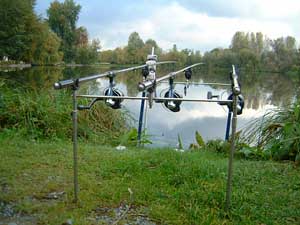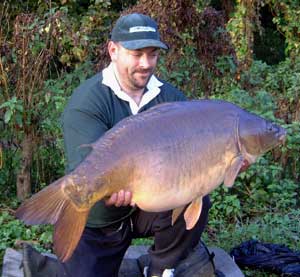|
|
| |
Rik started fishing at the age of four on his local tiny tidal river, catching eels and small wild trout on worm.
Not having had any angling family members, all his early fishing was solitary and this seems to have carried through to the present.
Like most anglers nowadays, he has a full time job and a family, so his fishing time is limited, although he does, he tells us, have a very understanding wife.He currently lives in the depths of Hampshire, and so is within easy reach of some excellent venues.
He has in the past, and still does, fish for most species, although his greatest love is for carp fishing, which is how the majority of his time is spent.
He now finds himself more thrilled with overcoming the intricacies and problems associated with catching carp, rather than the actual weight of the fish he catches and the so-called glory that goes with it.
Snag Fishing
It is widely known that carp hold up in snags. They regard these as safe havens for they provide cover and safety as well as food items. At times, efforts to draw the fish away from the snags with careful and selective baiting are successful, whilst on other occasions they can stubbornly refuse to co-operate and just poke their heads out occasionally.
It is at these times that we need to fish tighter to the snags to attempt to pick up bonus fish.
|
|
| |
The word safety is of paramount importance when dealing with snags and locations and rigs should be studied to ensure that they adhere to this safety principle. Snag fishing is one of the few times when I will voluntarily use a barbless hook, for accidents can happen when snag fishing and I wouldn’t want to leave a fish tethered.
Be Methodical
To minimise any problems a methodical approach to the situation is required. Questions to ask yourself are:
- Where are the fish in the snag?
- Where am I casting?
- Which direction will the fish run? / Which direction will I apply the pressure?
- Can I land a fish from there?
If any of the above questions cause you any concern then do not fish there, for the safety of the carp is the most important factor we must consider.
Snags come in many shapes and forms, and for the majority of us the snags we encounter are either marginal trees and bushes or trees that have fallen in. I would also classify lily pads as a snag.
Some other waters I fish have either whole or part ski ramps, old buildings or structures, that also provide snag situations.
The basic premise is always the same:
- Fish as close to the snags as you feel is safe
- Close enough to stand a chance of a bite
- But far enough away to be safe when you get a bite and
- Be able to safely land the fish.
Firstly we need to ensure that the area we have chosen to cast our bait to is snag-free. There is no point in fishing to the obvious visible snag above the waterline if it is festooned with hidden branches below.
The best way to approach this is to have a cast in the area with just a lead attached and no rig, preferably with a braided mainline to give you a more sensitive feel. This will allow you to get a mental picture of the area immediately around the snag. Snagged casts can normally be retrieved when there is just a lead attached.
Sometimes, especially with marginal bushes and trees, the area immediately below the canopy is clear and the obstructions don’t start to appear until you are several feet inside the periphery.
This is completely opposite to fallen tree snags, where the branches tend to collapse and spread out when they fall, leaving a large area of snags under the water that stretch beyond the obvious visible ones.
How far from the snag?
The distance we can safely fish from the snag is determined by several factors, the main two being:
- How far are we casting to reach the snag?
- How much stretch is in our line?
If we are casting 30 feet to a snag and our mono reel line has a 20% stretch factor, then we can deduce that once a carp is hooked and the tackle is taken to the extreme then our line will stretch by 6 feet.
Which line?
You could use braid as a reel line, but as the majority of braids have very poor abrasion resistance then they are not really suitable. If a fish was lost in the snag with braid attached, considering we tend to use increased breaking strains when using braid, then a tethered carp could do itself some terrible damage, so it is not recommended.
I tend to use Shimano Technium as my reel line, as it has only 5% stretch. Technium is two core mono/braid hybrid with an outer coating that gives it very good abrasion resistance. This means that my stretch factor, in the above example, is only 1 1/2 feet, allowing me to fish closer to the snag in more safety.
To also dampen the effects of any knocks or abrasions I coat the last ten or so feet of my line with Kryston’s Granite Juice, this puts a further protective coating around the mono to increase my chances and my confidence.
How close?
I cannot tell you how close to fish to a snag. You know how far away it is and how much stretch is in your line. You know what is safe and what is questionable and only you can decide how close to fish to it.
When casting to a snag (or any feature) the way I approach this is to firstly set up without a hooklink and then to cast to the snag, but ensure that the cast falls short. I then tighten up to the lead and attempt to gauge how far away from the snag the lead has landed.
|
|
| |
This is repeated until I am happy that the cast is landing in the correct place.I then take the line out of the line clip and tie on a marker at this point.Markers are either made from marker braid or powergum and the tails on the knot are left long enough so that they can be placed into the line clip to enable accurate recasts.
Accurate casts can only be repeated if you are standing in the same place every time, so pick a comfortable standing position and mark the ground where you are casting from.
Terminal tackle
The terminal set-ups I use are simplicity themselves. The hooklengths are either constructed from Kryston Snakebite or Snakeskin, as the outer coating on these materials gives fantastic protection against snags and abrasions.A good strong hook such as the Ashima C310, T6 Raptors or Nash Fang X are also required, as you are putting a lot of strain on the hook and you wouldn’t want it to open up or break when under pressure.
The lead arrangement is either an inline Nash Safety lead, where the lead has a slot cut into the body and a tube running through the middle. The lead can be opened or closed to increase or decrease the pressure needed to dislodge it from the set-up and this should be set so that it discharges with ease.
A pendent set-up, where the lead is in a Korda safety clip, where the tail rubber is only lightly pushed over the holding tag, again to make the lead discharge easier.
|
|
| medium weight indicator, and an additional rod rest, with protective towel, part way up the rod |
I have no further adornments in my set-up. No tubing, no leadcore and definitely no backleads.
Rod at 90 degrees
Once I have cast my rig to the spot I then place the rod at a 90 degree angle to the snag (or as close to this as bank conditions will allow) and fish as tight a line as possible between the rod tip and the lead. The tip of the rod is bent under tension and this provides the bolt rig effect and pressure to enable the rig to perform. I then attach a medium weight indicator as close to the rod blank as possible, so that there is no drop in the line to aid a taking fish, but any fish moving towards the rod and creating slack line will be noticed.Backleads are also a big no-no. The angle from rod tip to backlead means that there is a couple of feet of line available to a taking fish and this may be enough to allow it to reach its sanctuary.
This is also not the situation for baitrunners or slackened clutches to allow taking fish to run. The rods are at 90 degrees and there is no give anywhere in the set-up, the fish will pick up the bait and prick itself either against the weight of the lead or the tension in the rod tip. It will then, more than likely, attempt to regain the safety of the snag, but the tightened down set-up will not allow this, the rod tip will bend round and usually the fish will come straight to the surface. This will be accompanied by the bite alarm giving just a few strangled beeps and so these must be set as sensitively as possible.
|
|
| |
Rear rests will also need to be of the variety that grip, otherwise the rod butt will lift from the rests and the rod will swing towards the taking fish.This is also not the place for pods, but if bankside conditions mean that you can only use a pod, then either stake it down or, if on a wooden platform, screw it to the deck. With the amount of gear that most of us take, how much room does a cordless screwdriver take up?
Extra rod rest
Another useful addition to the set-up is an extra rod rest half way between the alarm and the rod tip, but it is placed next to the rod (on the snag side of the rod) and the rod top is placed against it. I generally wrap and tape a hand towel to the rest to protect the rod blank and it provides a useful stop so that the rod is not wrenched from the rests into the lake. This also puts the point at which the rod bends about a third of the way down from the tip and not at the alarm, meaning that the fish will once again not be able to take as much line when it initially bolts.
Remember – carp safety comes first
I hope I have covered all of the necessary areas in this article, but I will re-iterate one last time.
If you are unsure or feel that it is not safe to fish a spot, then do not do so.The safety of the carp is the most important aspect.
If you see others fishing in an unsafe manner, then politely attempt to put across some of the safety aspects that I have detailed here.
If anyone has any reservations or questions about this style of fishing, then post a question or comment to the carp forum and I’ll attempt to help further.










